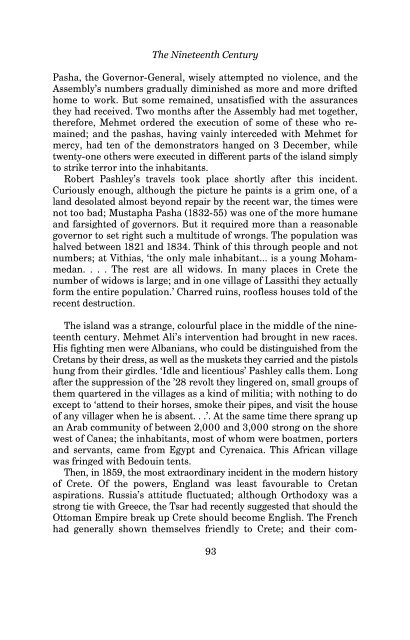free download here - Michael Llewellyn-Smith
free download here - Michael Llewellyn-Smith
free download here - Michael Llewellyn-Smith
Create successful ePaper yourself
Turn your PDF publications into a flip-book with our unique Google optimized e-Paper software.
The Nineteenth Century<br />
Pasha, the Governor-General, wisely attempted no violence, and the<br />
Assembly’s numbers gradually diminished as more and more drifted<br />
home to work. But some remained, unsatisfied with the assurances<br />
they had received. Two months after the Assembly had met together,<br />
t<strong>here</strong>fore, Mehmet ordered the execution of some of these who remained;<br />
and the pashas, having vainly interceded with Mehmet for<br />
mercy, had ten of the demonstrators hanged on 3 December, while<br />
twenty-one others were executed in different parts of the island simply<br />
to strike terror into the inhabitants.<br />
Robert Pashley’s travels took place shortly after this incident.<br />
Curiously enough, although the picture he paints is a grim one, of a<br />
land desolated almost beyond repair by the recent war, the times were<br />
not too bad; Mustapha Pasha (1832-55) was one of the more humane<br />
and farsighted of governors. But it required more than a reasonable<br />
governor to set right such a multitude of wrongs. The population was<br />
halved between 1821 and 1834. Think of this through people and not<br />
numbers; at Vithias, ‘the only male inhabitant... is a young Mohammedan.<br />
. . . The rest are all widows. In many places in Crete the<br />
number of widows is large; and in one village of Lassithi they actually<br />
form the entire population.’ Charred ruins, roofless houses told of the<br />
recent destruction.<br />
The island was a strange, colourful place in the middle of the nineteenth<br />
century. Mehmet Ali’s intervention had brought in new races.<br />
His fighting men were Albanians, who could be distinguished from the<br />
Cretans by their dress, as well as the muskets they carried and the pistols<br />
hung from their girdles. ‘Idle and licentious’ Pashley calls them. Long<br />
after the suppression of the ’28 revolt they lingered on, small groups of<br />
them quartered in the villages as a kind of militia; with nothing to do<br />
except to ‘attend to their horses, smoke their pipes, and visit the house<br />
of any villager when he is absent. . .’. At the same time t<strong>here</strong> sprang up<br />
an Arab community of between 2,000 and 3,000 strong on the shore<br />
west of Canea; the inhabitants, most of whom were boatmen, porters<br />
and servants, came from Egypt and Cyrenaica. This African village<br />
was fringed with Bedouin tents.<br />
Then, in 1859, the most extraordinary incident in the modern history<br />
of Crete. Of the powers, England was least favourable to Cretan<br />
aspirations. Russia’s attitude fluctuated; although Orthodoxy was a<br />
strong tie with Greece, the Tsar had recently suggested that should the<br />
Ottoman Empire break up Crete should become English. The French<br />
had generally shown themselves friendly to Crete; and their com-<br />
93


